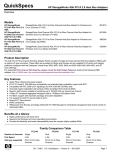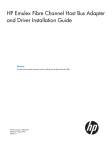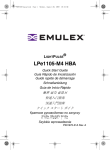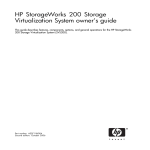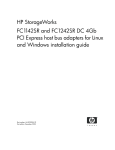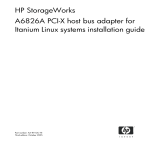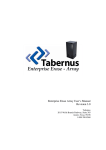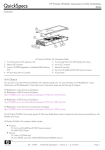Download HP FC1143 Reference Guide
Transcript
HP StorageWorks MultiPulse failover driver for Linux application notes Part number: AA-RWENC-TE Second edition: January 2007 Legal and notice information © Copyright 2006-2007 Hewlett-Packard Development Company, L.P. © Copyright 2006-2007 Emulex Corp. Confidential computer software. Valid license from HP required for possession, use or copying. Consistent with FAR 12.211 and 12.212, Commercial Computer Software, Computer Software Documentation, and Technical Data for Commercial Items are licensed to the U.S. Government under vendor's standard commercial license. The information contained herein is subject to change without notice. The only warranties for HP products and services are set forth in the express warranty statements accompanying such products and services. Nothing herein should be construed as constituting an additional warranty. HP shall not be liable for technical or editorial errors or omissions contained herein. Intel and Itanium are trademarks or registered trademarks of Intel Corporation or its subsidiaries in the United States and other countries. Linux is a U.S. registered trademark of Linus Torvalds. QLogic is a registered trademark of the QLogic Corporation. Red Hat is a trademark of Red Hat, Inc. SUSE is a registered trademark of Novell, Inc. About this document This document describes how to install and configure the Emulex MultiPulse driver for Linux® (MultiPulse). MultiPulse provides failover functionality for storage targets discovered through Emulex Fibre Channel host bus adapters (HBAs). When a path to a device fails, MultiPulse reroutes the I/O to an alternative path to that same device without disrupting service. This section describes the content reflected in this document, including: • • • • Application notes information, page 3 Intended audience, page 3 Accessing future product updates, page 3 Other documentation, page 3 Application notes information These application notes contain the following major topics: • • • • • • System requirements, page 4 Installing the driver, page 4 Uninstalling the driver, page 5 Driver parameters, page 6 Important information, page 6 Restrictions, page 7 Intended audience This document is intended for customers who purchased Emulex HBAs to use in a multipathing environment on Linux systems. Accessing future product updates HP strongly recommends that customers sign up online using the Subscriber's Choice website at http://www.hp.com/go/e-updates. • Subscribing to this service provides you with e-mail updates on the latest product enhancements, newest versions of drivers, and firmware documentation updates, as well as instant access to numerous other product resources. • After signing up, you can quickly locate your products by selecting Business support and then Storage under Product Category. Other documentation Additional documentation, including whitepapers and best-practices documents, is available on the HP website http://www.hp.com. MultiPulse failover driver for Linux application notes 3 System requirements Table 1 lists the supported operating systems, HBAs, and storage arrays. Table 1 System requirements Feature Requirement MultiPulse driver • 2.1.9 for (RHEL) 4, Updates 3 and 4; (SLES) 9, SP3 • 2.2.12 for (SLES) 10 Emulex base driver • 8.0.16.27 for (RHEL) 4, Updates 3 and 4; (SLES) 9, SP3 • 8.1.6.7 for (SLES) 10 Linux operating systems • Red Hat®Enterprise Linux (RHEL) 4, Updates 3 and 4 • SUSE®Linux Enterprise Server (SLES) 9, SP3 • SUSE®Linux Enterprise Server SLES 10 (x64, x86_x64 only) HBAs FC2142 4Gb PCI Express 2.0, product number A8002A FC2242 4Gb PCI Express 2.0, product number A8003A FC2143 4Gb PCI-X 2.0, product number AD167A FC2243 4Gb PCI-X 2.0, product number AD168A HP Emulex LPe1105-HP 4Gb FC HBA for HP c-Class BladeSystem, product number 403621-B21 Emulex-based BL25/30/35/45p Fibre Channel Mezz, product number 394588-B21 Emulex-based BL20p G3 Fibre Channel Mezz, product number 394757-B21 Storage arrays Enterprise Virtual Array (EVA): EVA3000/5000 EVA4000/6000/8000 XP Disk Array (XP): XP128/1024 XP10000/12000 Modular Smart Array (MSA): MSA A-A HBAnyware utility • 2.1a35 for (SLES) 9 and (RHEL) 4 • 3.1a9 for (SLES) 10 Installing the driver This section describes how to install the MultiPulse driver. About the HP Emulex Linux driver kit Use the driver kit to install the MultiPulse driver. The driver kit include two types of installations: single-path and multipath. For MultiPulse, you must use the multipath installation, which installs the following components: • Base HBA driver • MultiPulse driver • fibreutils HBA utility 4 Prerequisites Before you install the MultiPulse driver, ensure that your system meets the requirements described in "System requirements" on page 4. Driver installation To install the MultiPulse driver: 1. Enter the following command to untar hp-lpfc-<date>.tar.gz: # tar zxvf hp-lpfc-<date>.tar.gz The <date> is the release date of the .gz file. 2. Change to the newly created hp-lpfc-<date> directory: # cd hp-lpfc-<date> 3. Run the INSTALL script: # ./INSTALL -m When the installation is complete, the following RPMs are installed: • hp-lpfc – Base HBA driver • hp-multipulse – MultiPulse driver • fibreutils – Utility script NOTE: You must use the base driver in the hp-lpfc RPM. Uninstalling the driver Use one of the following methods to uninstall the driver: • Specify the -u flag with the INSTALL command: # ./INSTALL -u • Manually uninstall the kit by uninstalling the RPMs: # rpm -e hp-multipulse # rpm -e hp-lpfc # rpm -e fibreutils NOTE: To revert to the base HBA driver, uninstall only the hp-multipulse RPM: # rpm -e hp-multipulse MultiPulse failover driver for Linux application notes 5 Driver parameters Table 2 lists the MultiPulse driver parameters. Table 2 MultiPulse driver parameters Parameter Description lpfc_nodev_tmo Time, in seconds, that the driver holds I/O for a device that is no longer accessible. The default value is 30 seconds for single-path configurations. The MultiPulse installation changes this value to 10 seconds so that path failure notification occurs more quickly. lpfc_lun_queue_depth Queue depth per LUN. The default value is 16. The installation does not change the default value. lpfc_discovery_threads Number of kernel threads that are created during device discovery. The default value is 32. This value ensures that the discovery process occurs serially (one by one) in the order in which the name server in the fabric returns world wide names (WWNs). The installation does not change the default value. Important information Tape discovery issues The installation procedures for the Emulex Fibre Channel driver kits and the associated Linux fibreutils utility have changed for Enterprise Backup Solution (EBS) configurations. The MultiPulse driver (and fibreutils) release contains a fix for intermittent device discovery issues with SCSI-2 automated tape libraries. To implement the fix: 1. Install the HBA driver and fibreutils package using one of the following procedures: • Run the INSTALL script included in the driver kit. • Install the driver, optional multipath software, and fibreutils RPMs. 2. Enter the following commands to run the pbl script in the fibreutils directory: # cd /opt/hp/hp_fibreutils/pbl # ./pbl_inst.sh -i 3. Reboot the server to complete the installation. Note the following: • Running the pbl script installs the probe-luns utility, which runs probe-luns as part of the boot cycle. • Running the fix procedure (steps 1 through 3) eliminates the need to run hp_rescan –a in the /etc/rc.local directory for tape device discovery. If you previously added hp_rescan -a to rc.local (or another startup script), remove it from the rc.local. 6 Manual rescan When a server configured with MultiPulse first boots, MultiPulse automatically recognizes up to four physical paths and associates them with the same virtual device. However, after the initial configuration, MultiPulse does not recognize a new physical path that comes online to an already configured LUN. To enable MultiPulse to recognize the new physical path, you must perform a manual rescan using the hp_rescan utility. To manually rescan: 1. Ensure that the fibreutils RPM is installed on your system. 2. Enter the following command: hp_rescan –a New default per LUN queue depth For new installations, the default per LUN queue depth for Emulex HBAs on Linux systems has been changed to 16. Note that this affects new installations only, and does not affect upgrades. For upgrades, the current setting for queue depth is retained. Restrictions This section describes MultiPulse restrictions. • MultiPulse does not support older firmware on HP storage arrays. These storage arrays are known as active-passive storage arrays since not all paths are active on the fabric at the same time. These arrays include: • MSA1000 and MSA1500 running 4.x or 5.x firmware • EVA3000 and EVA5000 running VCS 3.x • If using MultiPulse 2.1.x, you can have a maximum of four physical paths to a LUN. More than four paths can cause improper failure. • If using MultiPulse 2.2.x, you can have a maximum of eight physical paths to a LUN. More than eight paths can cause improper failure. • MultiPulse can coexist with multipathing products such as QLogic® failover driver, Secure Path, or Device Mapper. However, note that MultiPulse only works with Emulex-based HBAs; it will not configure multiple paths for other HBAs in the system. • When using MultiPulse with SUSE Linux systems in Boot from SAN configurations, HP recommends that you use the Udev utility to ensure that your system successfully boots. For detailed information about this procedure, see "Using the Udev utility with SUSE Linux systems" in the Booting Itanium Linux systems from a storage area network application notes, available on the website http://h18006.www1.hp.com/storage/saninfrastructure.html. • XP LUNs presented to Linux hosts must start with LUN 0. • HP recommends that you implement zoning with HBA, as described in the HP StorageWorks SAN design reference guide, available on the websitehttp://h18006.www1.hp.com/products/ storageworks/san/documentation.html • HBAnyware: • Emulex HBAs may not appear in HBAnyware due to a conflict between library entries in /etc/hba.conf. After installing HBAnyware, run the following script from the HP driver kit to correct the problem: /opt/hp/hp-lpfc/remove_lpfc_hbaconf_entry.sh MultiPulse failover driver for Linux application notes 7








